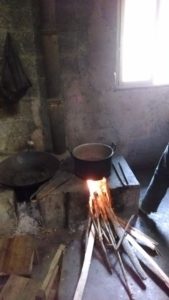Evaluating Household-level Drinking Water Treatment in Rural China
 After extensive discussion and planning, we started a collaborative research project with colleagues at the NCRWSTG and China CDC to characterize and assess methods of household water treatment (HWT) in low-income regions of rural China. During the first phase of this research, in the summer of 2013, we collected drinking water samples and administered surveys to 450 households across 15 rural villages in Guangxi province. To assess seasonal factors, we undertook a second round of data collection in the winter of 2013/2014 during which time we also affixed remote temperature sensors to kettles and pots to help corroborate reported boiling data. In 2014, under the supervision of China CDC colleagues Director Tao Yong and Dr. Qing Luo, we replicated the study in Henan province, collecting data from 450+ rural households during the summer. Using a variety of modeling approaches, we evaluated the microbiological effectiveness of the HWT methods used – including bottled water (large 19L bottles) – and isolated socioeconomic predictors associated with HWT and water-related beliefs and behaviors. Among other findings, we observed that indicators of fecal contamination were lowest in drinking water samples from households using electric kettles. Our analyses of boiling-associated air pollution indicated that switching from boiling with pots and solid fuels to boiling with electric kettles would result in a measurable reduction in indoor air pollution. We also observed relatively high rates of microbiological contamination in samples from households using bottled water; and our analyses of socioeconomic factors suggested that rural bottled water use will continue to increase in the future. Results from these studies – as well as a systematic review on boiling and health outcomes – were also used to support and inform the design of an intervention to promote the use of electric kettles in low-income rural communities (see project summary above).
After extensive discussion and planning, we started a collaborative research project with colleagues at the NCRWSTG and China CDC to characterize and assess methods of household water treatment (HWT) in low-income regions of rural China. During the first phase of this research, in the summer of 2013, we collected drinking water samples and administered surveys to 450 households across 15 rural villages in Guangxi province. To assess seasonal factors, we undertook a second round of data collection in the winter of 2013/2014 during which time we also affixed remote temperature sensors to kettles and pots to help corroborate reported boiling data. In 2014, under the supervision of China CDC colleagues Director Tao Yong and Dr. Qing Luo, we replicated the study in Henan province, collecting data from 450+ rural households during the summer. Using a variety of modeling approaches, we evaluated the microbiological effectiveness of the HWT methods used – including bottled water (large 19L bottles) – and isolated socioeconomic predictors associated with HWT and water-related beliefs and behaviors. Among other findings, we observed that indicators of fecal contamination were lowest in drinking water samples from households using electric kettles. Our analyses of boiling-associated air pollution indicated that switching from boiling with pots and solid fuels to boiling with electric kettles would result in a measurable reduction in indoor air pollution. We also observed relatively high rates of microbiological contamination in samples from households using bottled water; and our analyses of socioeconomic factors suggested that rural bottled water use will continue to increase in the future. Results from these studies – as well as a systematic review on boiling and health outcomes – were also used to support and inform the design of an intervention to promote the use of electric kettles in low-income rural communities (see project summary above).
